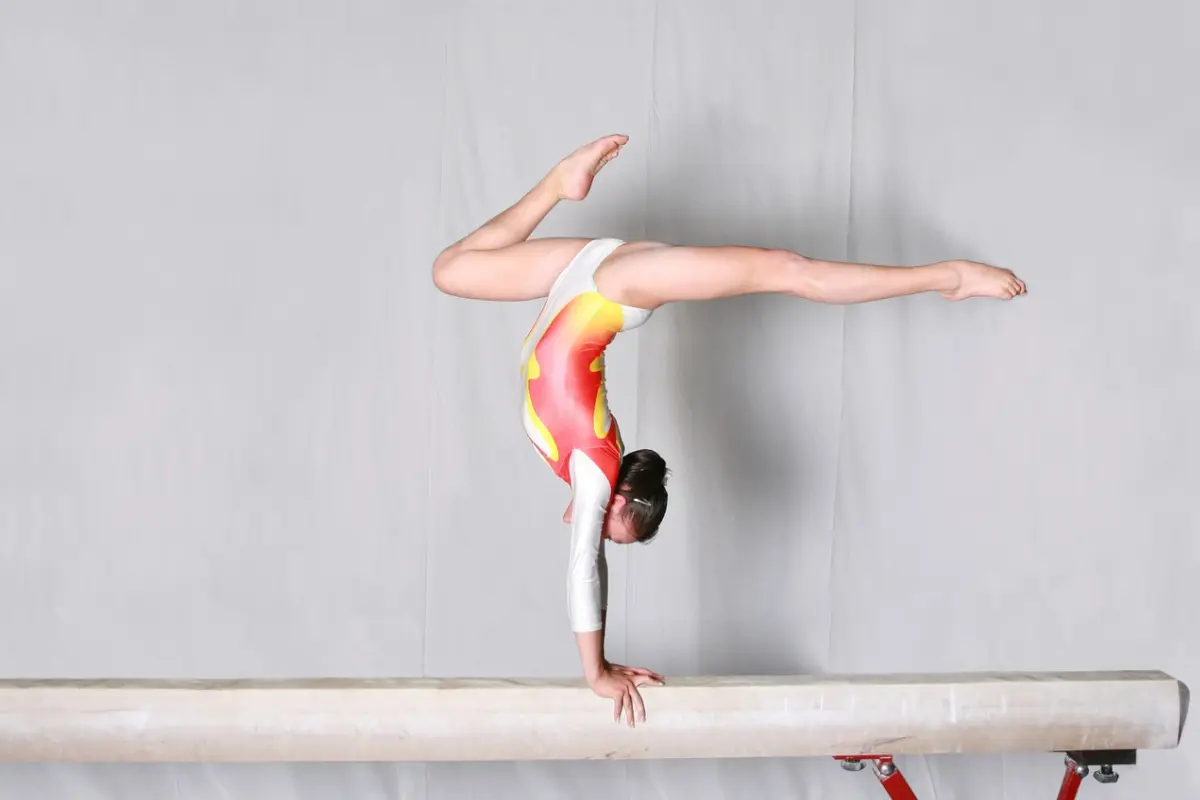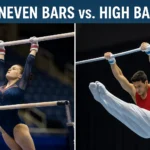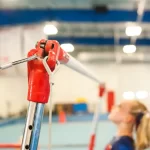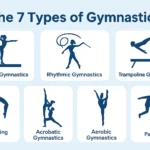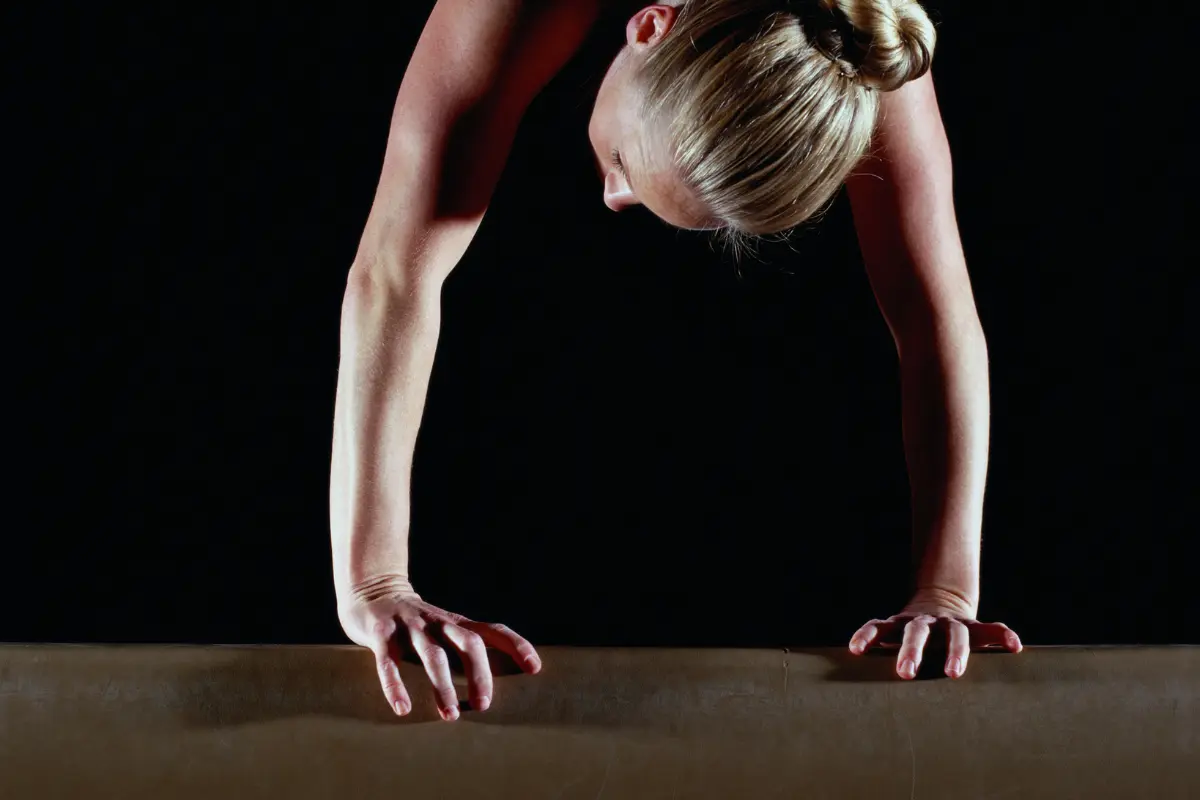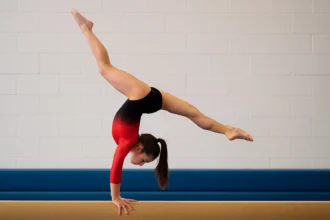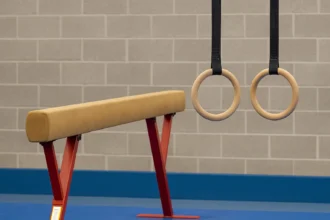The balance beam is one of the most technically demanding apparatuses in artistic gymnastics. Just 10 cm (4 inches) wide, it requires strength, precision, flexibility, and confidence. Every beam routine is made up of a mix of mounts, basic movements, dance elements, acrobatic skills, and a well-executed dismount.
Mounts
The mount is the gymnast’s first interaction with the balance beam, and it sets the stage for the entire routine. From the moment the gymnast steps onto the competition floor, judges are already watching: posture, confidence, and execution matter before the first acrobatic skill is even attempted.
Mounts can be simple, stable entries at beginner levels or high-difficulty acrobatic elements in elite competition. They not only start the routine but can also contribute valuable Difficulty Value (DV) to the overall score if performed cleanly.
Examples of Common Mounts
| Skill | Description | DV |
|---|---|---|
| Jump to Front Support | Jump from floor, landing in a push-up position on the beam before swinging to sit or stand. Common in beginner levels for stability. | A |
| Straddle Mount | Swing one leg over the beam into a seated straddle before transitioning to standing. | A |
| Press to Handstand Mount | Press from floor or beam into a handstand, then lower to starting position. Requires core, shoulder, and flexibility strength. | C |
| Cartwheel Mount | Dynamic entry that lands directly in a standing or lunge position on the beam. | B |
| Back Handspring Mount | A powerful, high-level entry landing in a controlled stand. Often used in optional and elite routines. | D |
Walking & Basic Movements
Walking on the balance beam might look simple to spectators, but in gymnastics, it’s a judged skill category that demands precision, posture, and artistry. These movements connect bigger skills, keep the routine flowing, and showcase a gymnast’s control on the narrow surface.
Even at the highest levels, elite gymnasts use walking variations to maintain choreography, adjust pacing, and hit artistry requirements.
Examples of Common Walking Skills
| Skill | Description | DV |
|---|---|---|
| Relevé Walk | Walking on tiptoes along the beam to display balance and elegance. Often paired with arm choreography. | A |
| Passé Walk | Walking while bringing the working foot to the opposite knee at each step. Highlights body line and control. | A |
| Side Step with Leg Lift | Sideways step across the beam, lifting the free leg to the side for extension and variation. | A |
| Backward Walk | Stepping backward along the beam without looking down, testing awareness and balance. | A |
Dance Elements: Leaps & Jumps
Dance elements are where a gymnast brings artistry, rhythm, and expression to the balance beam. In competitive gymnastics, they are required composition elements and must meet strict split angle and body shape standards to avoid deductions.
Leaps and jumps also contribute difficulty value (DV) to the score and, when connected directly to acrobatic skills, can earn connection value (CV) in optional and elite routines.
Leaps
Leaps involve traveling through the air with a split, scissor, or other body shape. To receive full DV, the leap must reach the required split angle (often 180° in higher levels).
| Skill | Description | DV |
|---|---|---|
| Split Leap | A forward-traveling leap with legs extended into a full split in mid-air. Standard in all levels. | B |
| Switch Leap | Begins like a split leap, but the legs switch mid-air, requiring explosive power. | C |
| Switch Half | Switch leap combined with a 180° turn in mid-air for added complexity. | D |
| Sissonne | A leap from two feet to one foot with a scissoring leg action and a split in the air. | A |
Jumps
Jumps are vertical takeoffs from one or both feet, emphasizing height, body position, and control. Many jumps require a precise shape to be held at the peak.
| Skill | Description | DV |
|---|---|---|
| Tuck Jump | A jump with knees pulled tightly to the chest, arms often in high position. | A |
| Wolf Jump | A jump with the torso leaning forward and one leg bent underneath, the other extended forward. | A |
| Sheep Jump | A jump arching the back with feet aimed toward the head, requiring high flexibility. | D |
| Split Jump | Jump from two feet into a split position in mid-air without forward travel. | B |
Turns
Turns on the balance beam test balance, body alignment, and core control more than almost any other skill category. Even though many turns are lower in difficulty value compared to big acro skills, they can make or break a routine’s flow — and they’re required in most competitive levels.
For higher difficulty, gymnasts often add flexibility positions (like a leg held in Y position) or increase the number of rotations. The challenge comes from maintaining perfect posture and spotting while rotating on a surface only four inches wide.
Common Beam Turns
| Skill | Description | DV |
|---|---|---|
| Full Turn (360°) | Performed in passé position; a required skill in many compulsory and optional levels. | A |
| Double Turn (720°) | Two full rotations in passé position, requiring exceptional stability and spotting. | C |
| Y-Turn | Rotation performed with one leg held extended to the side at hip or above. Tests flexibility and balance. | D |
| Illusion Turn | Forward-leaning turn where the free leg sweeps overhead in a circular motion. Requires strong hamstrings and core. | C |
Acrobatic Skills (Acro Moves)
Acrobatic skills are the most dynamic and high-risk elements on the balance beam. They bring flight, power, and difficulty value (DV) to a routine, but they also carry higher deduction risks if control or alignment is lost.
Beam acro skills are divided into forward, backward, and side categories, each requiring different entry mechanics, air awareness, and landing techniques. They can be performed as single elements or in acro series for connection bonuses.
Forward Acro
| Skill | Description | DV |
|---|---|---|
| Front Walkover | Controlled bridge-like motion into a forward step, requiring flexibility and core strength. | B |
| Front Handspring | Powerful forward flight with hands contacting the beam before landing on the feet. | C |
| Front Aerial | Forward salto without hands touching the beam — high air awareness required. | D |
Backward Acro
| Skill | Description | DV |
|---|---|---|
| Back Walkover | Controlled bridge motion moving backward into a step, maintaining alignment on the beam. | B |
| Back Handspring | A staple in acro series; backward flight from hands to feet. | B |
| Back Layout | Straight-bodied backward salto requiring height, control, and perfect takeoff. | D |
Side Acro
| Skill | Description | DV |
|---|---|---|
| Side Aerial | Sideways salto without hands, demanding strong takeoff and landing precision. | D |
| Side Somersault | Rare, elite-level sideways salto with tucked or piked shape. | E |
Acro/Dance Combinations
Acro/dance combinations link a tumbling element with a leap, jump, or turn. In optional and elite gymnastics, these connections can earn Connection Value (CV), bonus tenths added to the difficulty score when skills are performed without pauses or balance checks.
These combinations also enhance the flow and artistry of a routine, showing the gymnast’s ability to blend athletic power with expressive movement on a four-inch-wide surface.
Examples of Acro/Dance Combinations
| Combination | Description | CV Bonus |
|---|---|---|
| Split Jump → Back Handspring | Leaping into a split jump immediately followed by a back handspring; combines artistry and flight. | 0.10 |
| Switch Leap → Back Tuck | Power and flexibility meet in this leap directly into a backward salto. | 0.20 |
| Wolf Jump → Front Aerial | Dynamic jump connected to a no-hand forward salto for originality and style. | 0.10 |
Dismounts
The dismount is the final skill of a beam routine. Judges expect a controlled, stuck landing with a proper salute, and in higher levels, the dismount’s difficulty value (DV) can significantly boost the overall score.
A dismount should not feel tacked on at the end. The best ones are integrated seamlessly into the routine’s flow and performed with the same precision and artistry as the rest of the performance.
Examples of Common Dismounts
| Skill | Description | DV |
|---|---|---|
| Cartwheel Dismount | A basic, controlled exit from the beam, often used in lower levels. | A |
| Round-Off Back Tuck | Dynamic backward salto from a round-off entry; common in mid-level routines. | C |
| Full-Twisting Layout | Backward layout with a full twist; requires height, control, and strong spotting. | E |
| Double Back Dismount | Two backward saltos in succession; an elite-level skill demanding explosive takeoff and precise landing control. | E |
Mastering beam skills is about more than just learning difficult moves, it’s about combining control, artistry, and confidence from start to finish. With practice and precision, every gymnast can turn the balance beam into a place to shine.
